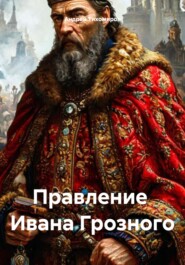По всем вопросам обращайтесь на: info@litportal.ru
(©) 2003-2025.
✖
The Reign of Ivan the Terrible
Настройки чтения
Размер шрифта
Высота строк
Поля
Андрей Тихомиров
The reign of Ivan the Terrible, the first Russian tsar, left an indelible mark on the history of Russia. His life, full of dramatic events, has attracted the attention of historians and writers for centuries. Ivan IV was a complex and controversial personality: a highly educated patron of printing, a talented writer and statesman, he did much to strengthen and expand the Russian state. However, his reign was also accompanied by the destruction of his own achievements and brutal repression. This contrast between greatness and destructive power makes his figure one of the most tragic in the history of Russia.
Андрей Тихомиров
The Reign of Ivan the Terrible
Unification of Russian lands
The unification of the Russian lands ended under Ivan III's son, Vasily III, who ruled in Moscow from 1505 to 1533. In place of the disparate principalities, a large state of Russia appeared, spread over 2,800 thousand square kilometers. It was a single state, where all cities and lands were subordinate to the Grand Duke. The population of Russia was 9 million people. Previously, the appanage princes were the rulers of their lands, but now they have become the boyars of the Grand Duke and entered the Boyar Duma. It was a council of noble people who helped the prince solve important issues. The decrees said: "The Grand Duke ordered, and the boyars were sentenced." However, there were still traces of feudal fragmentation in the country. Some boyar princely states retained their possessions and felt like little rulers. They had their own squads and did not always obey Moscow. In the 16th century, the Moscow government fought against this in order to strengthen the central government. Before his death, Vasily III bequeathed the throne to his son Ivan, who was only three years old at the time. The state was ruled by his mother, Princess Elena, with her brothers, the Princes of Glinsky.
When Ivan grew up, disputes for power began. His uncles, the brothers of Vasily III, wanted to rule themselves, but the Glinskys defeated them and sent them to prison. But after Elena's death, the Shuisky princes seized power, then the Belsky. In 1546, the Glinskys returned to power.
These changes were often accompanied by violence and killings. The boyars who ruled the country used their power for personal gain.
Ivan IV, the future tsar Ivan the Terrible, witnessed all these events. He also sometimes intervened in the struggle for power. In 1543, he ordered the execution of Prince Andrei Shuisky, and in 1546– two princes Vorontsov. In January 1547, Ivan turned 17 years old, and he was crowned king in the Assumption Cathedral of the Kremlin. Metropolitan Macarius put a golden crown on him and proclaimed him an autocratic tsar. Ivan became the first tsar of Russia. This event strengthened his power and increased the international prestige of the country.
In February 1547, Ivan married Anastasia, the daughter of the Moscow boyar Roman Zakharin. From that moment on, he became an adult and could manage the state himself.
Ivan IV, known as Ivan the Terrible, received a good education under the guidance of Metropolitan Macarius. He read a lot and studied the history of Kievan Rus, the Principality of Vladimir and European countries. Ivan realized early on that many princes and boyars did not want to unite Russia, but wanted to be independent rulers in their lands. He decided to strengthen the state and make it stronger.
Ivan was an intelligent and talented man. In his youth, he surprised everyone with his knowledge and thoughts. He was a good politician, diplomat and military commander. But he had a difficult personality: he often got angry and lost his temper. Since childhood, Ivan has been suspicious and violent. He did not tolerate disobedience and could punish even a small offense.
At a time when the country was ruled by boyars, the life of peasants and townspeople became very difficult. The Boyars took away a lot of money and land from people, and the peasants suffered from this. In some places, people began to rebel against the boyars.
In 1547, a great fire broke out in Moscow. The fire destroyed almost all the houses and killed many people. It was a terrible disaster, and many were left homeless and without food. People started accusing the Boyars of arson and rebelled. The crowd broke into the Assumption Cathedral and killed one of the boyars.
Ivan the Terrible was very frightened by these events. He decided to change the government and brought new people closer to him, who were not connected with the boyars. These people were nobles who received lands and positions from the tsar in exchange for service.
The nobles were interested in the strong power of the tsar because he gave them lands and the opportunity to serve the state. Ivan the Terrible wanted everyone to live peacefully and amicably, and for the country to be strong and united.
Ivan IV, known as Ivan the Terrible, created a new government called the Elected Rada. It included nobles and boyars loyal to him, who wanted Moscow to become even stronger. The rada was led by nobleman Alexei Adashev. Priest Sylvester and Prince Andrey Kurbsky, Ivan's childhood friend, also played an important role.
The elected rada sought to unite the country and establish good relations between boyars, nobles and the church. In 1549, Ivan IV convened the first Zemsky Sobor, an assembly of representatives of different classes. At it, the tsar accused the boyars of abuses and called on everyone to work together to strengthen the state. In the future, such cathedrals were held to resolve important state issues.
The elected rada has carried out many reforms. She expanded the administrative orders, changed the order of administration of cities and municipalities. Previously, Boyar governors tried people and collected taxes, but did not receive any money for it. The elected rada abolished this system and appointed voivodes who were paid by the state. Tax collection and court cases were handed over to the elders of the nobility. A new judicial code, a collection of laws, was also created.
Ivan IV wanted to reach the Baltic Sea in order to develop trade and culture with Western Europe. To do this, it was necessary to break through the blockade created by hostile Poland, Lithuania and the Livonian Order. The Baltic lands once belonged to Novgorod and Pskov, but then they were captured by the knights. In 1501, they tried to capture Pskov, but were defeated by Russian troops. In 1503, they concluded a truce for 50 years and pledged to pay tribute to Moscow. But over time, the order stopped fulfilling the contract and began to harm Russia.
In 1547, the order did not allow European specialists to enter Russia. Ivan IV was busy with business in the East and did not punish the master of the order. But in 1554, Livonian ambassadors came to Moscow to ask for an extension of the truce. Ivan IV demanded that they pay the tribute stipulated in the 1503 treaty. The ambassadors agreed, but they were not going to fulfill their promise. The new master of the order has formed an alliance against Russia. Ivan IV had every reason to declare war on the Livonian Order.
In January 1558, Russian soldiers crossed the border of Livonia near the city of Pskov. Tsar Ivan IV declared war and called on everyone to help the country. Bells were ringing in Moscow, and people were fasting.
The Livonian Order was weak due to quarrels between Germans, Latvians and Estonians. But Russia had to fight not only with Livonia, but also with the allies of Poland and Lithuania. At first, the Russians won: they took Narva, Dorpat, and reached the Baltic Sea and the borders of Lithuania. They were helped by local residents who were tired of the oppression of the feudal lords. The Livonian Order was rapidly falling apart. The tsar rejoiced at his successes and held celebrations. But many boyars did not want to fight and defend Livonia. They believed that it was necessary to defend themselves from the Tatars and did not want to give up the land.
The Boyars were afraid of losing their lands and saw no point in taking over. They were unhappy with the increased taxes and duties. The tsar wanted to continue the war in order to gain new lands and wealth. While Russia was winning, these differences were not noticeable. But when the setbacks began, the tsar began to persecute the boyars so that they would obey. He wanted to make them obedient. The feudal lords thought only of their lands and did not want to fight for Livonia. The tsar's advisers, such as Sylvester and Alexei Adashev, said that a war with Poland and Lithuania would be difficult. Under their influence, the tsar decided to take a break from the war in the summer of 1559. This was a mistake, as the enemies had time to prepare.
When Russia successfully fought in the Livonian War, its successes alarmed its neighbors. Therefore, when the new head of the Livonian Order, Gotthard Kettler, turned to other countries for help, Poland and Sweden decided to intervene. In 1561, Kettler transferred part of the lands to Poland, and part to Sweden and Denmark. The Order ceased to exist, and Russia had to fight several strong opponents at once: Poland, Lithuania, Sweden and Denmark.
Ivan the Terrible, despite all the difficulties, did not want to accept defeat and decided to continue the war. But the war dragged on for many years. In 1563, Russian troops captured the important city of Polotsk, but were soon defeated and lost the city. In 1564, one of the tsar's closest advisers, Andrei Kurbsky, defected to the enemy. In 1566, Ivan the Terrible decided to discuss the war with the people at the Zemsky Sobor, but the majority supported the continuation of the war.
Вы ознакомились с фрагментом книги.
Приобретайте полный текст книги у нашего партнера:
Приобретайте полный текст книги у нашего партнера:

















